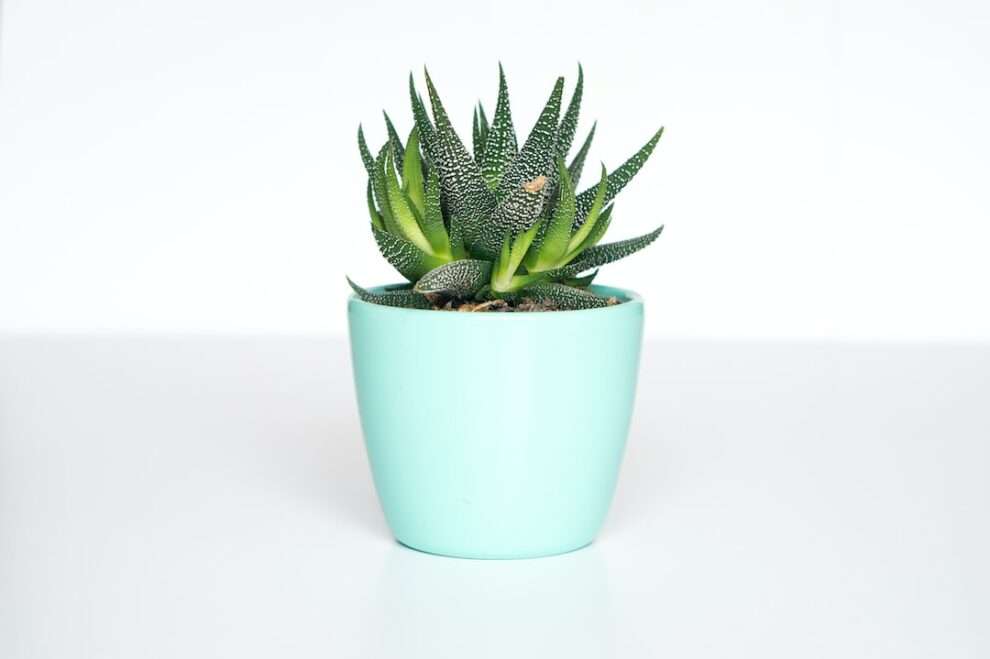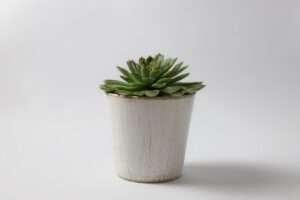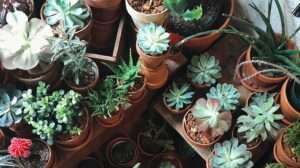Succulent plants are a type of plant that have thick, fleshy leaves and stems that store water. This adaptation allows them to survive in arid environments where water is scarce. Succulents come in a wide variety of shapes, sizes, and colors, making them a popular choice for indoor and outdoor gardens.
There are many different types of succulent plants, each with its own unique characteristics. Some popular types include Aloe vera, Echeveria, Sedum, and Crassula. These plants can range in size from small, compact varieties to larger, tree-like specimens. They also come in a wide range of colors, from vibrant greens to deep purples and even shades of red and orange.
One of the main benefits of growing succulent plants is their low maintenance nature. Succulents are known for their ability to thrive in dry conditions and can go for long periods without water. This makes them an ideal choice for busy individuals or those who may not have a green thumb. Additionally, succulents are known for their air-purifying properties, making them a great addition to any indoor space.
Choosing the Right Soil for Succulents
When it comes to growing succulents, choosing the right soil is crucial for their overall health and well-being. Succulents require well-draining soil that allows excess water to flow through easily. This is because their thick leaves and stems store water, and if the soil retains too much moisture, it can lead to root rot and other issues.
Good soil for succulents should be a mix of organic matter and inorganic materials such as sand or perlite. This combination helps create a well-draining environment while still providing some nutrients for the plants. Avoid using regular potting soil or garden soil, as these tend to retain too much moisture and can suffocate the roots of succulent plants.
If you prefer to make your own succulent soil mix, you can do so by combining equal parts of potting soil, sand, and perlite. This will create a well-draining mixture that is suitable for most succulent plants. Alternatively, you can purchase pre-made succulent soil mixes from garden centers or online retailers.
Watering Techniques for Succulent Care
Watering succulent plants can be a bit tricky, as they have different water requirements compared to other types of plants. In general, succulents prefer to be underwatered rather than overwatered. Overwatering can lead to root rot and other issues, while underwatering can cause the plants to become dehydrated and shriveled.
The frequency of watering will depend on various factors such as the type of succulent, the size of the pot, and the environmental conditions. As a general rule of thumb, it is best to wait until the soil is completely dry before watering again. This can range from every 1-2 weeks during the growing season to once every few weeks during the dormant period.
Signs of overwatering include yellowing or mushy leaves, a foul smell coming from the soil, and wilting despite being watered. On the other hand, signs of underwatering include shriveled leaves, a wrinkled appearance, and a dry or brittle texture.
When it comes to watering succulents, it is best to use the soak and dry method. This involves thoroughly watering the plant until water drains out of the bottom of the pot and then allowing the soil to dry out completely before watering again. This mimics their natural habitat where they experience periods of heavy rainfall followed by long periods of drought.
Understanding Sunlight Needs for Succulents
Succulents are known for their love of sunlight and thrive in bright, indirect light conditions. Most succulent plants require at least 6 hours of sunlight per day to grow and thrive. However, it is important to note that not all succulents have the same sunlight requirements, and some may prefer more shade or less intense light.
Signs of too much sunlight include sunburned leaves, which appear brown or yellow and may have a bleached appearance. On the other hand, signs of too little sunlight include elongated stems and pale or stretched out leaves.
When it comes to placing succulent plants, it is best to choose a location that receives bright, indirect light for most of the day. This can be near a south-facing window or in a well-lit area of your garden. If you notice that your succulents are not receiving enough light, you can supplement with artificial grow lights to ensure they get the necessary amount of light.
Propagation Methods for Succulent Plants
One of the great things about succulent plants is their ability to propagate easily. There are several different methods you can use to propagate succulents, including leaf cuttings, stem cuttings, and division.
Leaf cuttings involve removing a healthy leaf from the parent plant and allowing it to dry out for a few days. Once the cut end has calloused over, you can place the leaf on top of well-draining soil and mist it lightly with water. After a few weeks, roots will begin to form, and a new plant will start to grow.
Stem cuttings involve cutting off a healthy stem from the parent plant and allowing it to dry out for a few days. Once the cut end has calloused over, you can place the stem in well-draining soil and mist it lightly with water. After a few weeks, roots will begin to form, and a new plant will start to grow.
Division is another method of propagation that involves separating a clump of succulents into individual plants. This is typically done when the parent plant has become too large or overcrowded. To divide succulents, carefully remove the plant from its pot and gently separate the roots. Each individual plant can then be potted up in its own container.
Fertilizing Succulents: Dos and Don’ts

While succulents are known for their ability to survive in nutrient-poor environments, they still benefit from occasional fertilization. Fertilizing succulents can help promote healthy growth and vibrant colors. However, it is important to use the right type of fertilizer and apply it correctly to avoid damaging the plants.
When it comes to fertilizing succulents, it is best to use a balanced, water-soluble fertilizer with a low nitrogen content. Nitrogen promotes leafy growth, which is not ideal for succulents that are prized for their compact, fleshy leaves. Look for a fertilizer with an NPK ratio of 10-10-10 or similar.
It is best to fertilize succulents during the growing season, which is typically spring and summer. Avoid fertilizing during the dormant period, as the plants are not actively growing and do not require additional nutrients.
When applying fertilizer, dilute it to half strength or less to avoid overfertilization. Apply the diluted fertilizer to moist soil, as this will help prevent burning the roots. It is also a good idea to flush the soil with plain water every few months to remove any built-up salts from the fertilizer.
Identifying Common Succulent Pests and Diseases
Like all plants, succulents are susceptible to pests and diseases. Some common pests that can affect succulent plants include mealybugs, aphids, spider mites, and scale insects. These pests can cause damage to the leaves and stems of succulents and can even lead to plant death if left untreated.
Signs of pest infestation include small, crawling insects on the leaves or stems, sticky residue on the plant, and yellowing or distorted leaves. If you notice any of these signs, it is important to take action immediately to prevent further damage.
To treat pest infestations, you can use insecticidal soap or neem oil. These products are safe to use on succulents and can help control pests. It is important to follow the instructions on the product label and apply it as directed.
In addition to pests, succulents can also be prone to diseases such as root rot and fungal infections. These issues are often caused by overwatering or poor drainage. Signs of disease include wilting, yellowing or browning leaves, and a foul smell coming from the soil.
To treat and prevent diseases, it is important to ensure that your succulents are planted in well-draining soil and that you are not overwatering them. If you suspect that your succulent has a disease, it is best to remove the affected parts of the plant and treat it with a fungicide if necessary.
Transplanting Succulents: When and How to Do It
Transplanting succulents is necessary when the plant has outgrown its current pot or when the soil has become compacted and does not drain properly. Signs that your succulent plant needs to be transplanted include roots growing out of the drainage holes, slow growth, and wilting despite being watered.
To transplant a succulent, start by selecting a new pot that is slightly larger than the current one. Fill the new pot with well-draining soil and create a hole in the center for the plant. Carefully remove the succulent from its current pot, being careful not to damage the roots. Place the plant in the new pot and fill in any gaps with additional soil.
After transplanting, it is important to water the succulent thoroughly to help settle the soil and remove any air pockets. Allow the plant to adjust to its new pot for a few days before placing it in its desired location.
Tips for Arranging Succulent Plants in Containers
Succulents are often used in container gardens and arrangements due to their unique shapes and colors. When it comes to arranging succulent plants in containers, there are a few tips to keep in mind to create a visually appealing display.
First, choose a container that has good drainage and is the appropriate size for the plants you are using. Succulents prefer to be slightly root-bound, so choose a pot that is just slightly larger than the root ball of the plant.
When arranging succulents, consider using a variety of shapes, sizes, and colors to create visual interest. Place taller plants in the center or back of the container and surround them with smaller, trailing varieties. You can also mix different types of succulents together or combine them with other types of plants such as cacti or ornamental grasses.
To care for your succulent arrangement, water it sparingly and ensure that it receives adequate sunlight. Rotate the container every few weeks to ensure that all sides of the plants receive equal light exposure.
Frequently Asked Questions about Succulent Care
Q: How often should I water my succulent plants?
A: The frequency of watering will depend on various factors such as the type of succulent, the size of the pot, and the environmental conditions. As a general rule of thumb, it is best to wait until the soil is completely dry before watering again. This can range from every 1-2 weeks during the growing season to once every few weeks during the dormant period.
Q: Can I grow succulents indoors?
A: Yes, succulents can be grown indoors as long as they receive adequate sunlight. Place them near a south-facing window or use artificial grow lights to ensure they get the necessary amount of light.
Q: How do I know if my succulent is getting too much or too little sunlight?
A: Signs of too much sunlight include sunburned leaves, which appear brown or yellow and may have a bleached appearance. Signs of too little sunlight include elongated stems and pale or stretched out leaves.
Q: How do I propagate succulent plants?
A: Succulents can be propagated through leaf cuttings, stem cuttings, or division. Leaf cuttings involve removing a healthy leaf from the parent plant and allowing it to dry out before placing it on top of well-draining soil. Stem cuttings involve cutting off a healthy stem and allowing it to dry out before planting it in soil. Division involves separating a clump of succulents into individual plants.
Q: Do succulents need fertilizer?
A: While succulents can survive in nutrient-poor environments, they still benefit from occasional fertilization. Use a balanced, water-soluble fertilizer with a low nitrogen content during the growing season.
In conclusion, succulent plants are a popular choice for indoor and outdoor gardens due to their unique characteristics and low maintenance nature. When growing succulents, it is important to choose the right soil that allows for proper drainage and to water them sparingly to avoid overwatering. Understanding their sunlight needs and providing adequate light is also crucial for their overall health and well-being. Propagation, fertilization, pest and disease control, transplanting, and arranging succulents are all important aspects of succulent care that should be considered. By following these tips and guidelines, you can successfully grow and care for your own beautiful succulent garden.
If you’re a beginner looking to care for your succulents, you may be wondering if they can handle full sun exposure. In a related article on GirlsGist, they explore the topic of sun-loving succulents and whether or not they can thrive in direct sunlight. To learn more about this fascinating subject, check out their article “Sun-Loving Succulents: Can They Handle Full Sun Exposure?“. This informative piece will provide you with valuable insights and tips on how to best care for your sun-loving succulents.
FAQs
What are succulents?
Succulents are plants that store water in their leaves, stems, and roots. They come in a variety of shapes, sizes, and colors and are known for their ability to thrive in dry and arid conditions.
What are the basic requirements for succulent care?
Succulents require well-draining soil, adequate sunlight, and infrequent watering. They also benefit from occasional fertilization and pruning.
How often should I water my succulents?
Succulents should be watered only when the soil is completely dry. This can range from once a week to once a month, depending on the climate and the type of succulent.
What kind of soil is best for succulents?
Succulents require well-draining soil that allows excess water to flow out quickly. A mixture of sand, perlite, and potting soil is a good option.
How much sunlight do succulents need?
Most succulents require at least six hours of direct sunlight per day. However, some varieties can tolerate partial shade.
What should I do if my succulent is not thriving?
If your succulent is not thriving, it may be due to overwatering, lack of sunlight, or poor soil drainage. Adjusting these factors can help your succulent recover.

















Add Comment